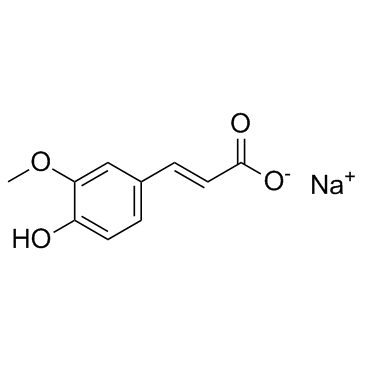24276-84-4
| Name | Sodium ferulic |
|---|---|
| Synonyms |
3-(4-Hydroxy-3-methoxyphenyl)-2-propenoic acid monosodium salt
Natrium-(2E)-3-(4-hydroxy-3-methoxyphenyl)prop-2-enoat 2-Propenoic acid,3-(4-hydroxy-3-methoxyphenyl)-,monosodium salt MFCD00075727 Monosodium 3-(4-hydroxy-3-methoxyphenyl)-2-propenoate Sodium (2E)-3-(4-hydroxy-3-methoxyphenyl)acrylate (2E)-3-(4-hydroxy-3-methoxyphenyl)prop-2-enoic acid, sodium salt Sodium (2E)-3-(4-hydroxy-3-methoxyphenyl)prop-2-enoate Sodium Ferulate Monosodium 4-hydroxy-3-methoxycinnamate Ferulic acid sodium salt 2-Propenoic acid, 3-(4-hydroxy-3-methoxyphenyl)-, monosodium salt 2-Propenoic acid, 3-(4-hydroxy-3-methoxyphenyl)-, sodium salt, (2E)- (1:1) 4-HYDROXY-3-METHOXYCINNAMIC ACID SODIUM SALT Cinnamic acid,4-hydroxy-3-methoxy-,monosodium salt Sodium 3-(4-hydroxy-3-methoxyphenyl)acrylate Sodium 4-hydroxy-3-methoxycinnamate Ferulic acid (sodium) |
| Description | Ferulic acid (4-hydroxy-3-methoxycinnamic acid) is a phenolic compound present in several plants with claimed beneficial effects in prevention and treatment of disorders linked to oxidative stress and inflammation.IC50 value:Target: 5-HT ReceptorIn vitro: In the present study we have showed that pre-treatment with Ferulic Acid (FA) reduces NO accumulation in the culture medium of LPS-induced macrophage cells. Moreover, real-time experiments have revealed that FA has an inhibitory effect at the transcriptional level on the expression of some inflammatory mediators such as IL-6, TNF-α and iNOS and an activation effect on the expression of some antioxidant molecules such as Metallothioneins (MT-1, MT-2). Importantly, we have found that FA reduced the translocation of NF-E2-related factor 2 (Nrf2) and nuclear transcription factor-κB (NF-κB) into the nuclei through a reduction of the expression of phosphorylated IKK and consequently inhibited IL-6 and NF-κB promoter activity in a luciferase assay [1]. FA treatment significantly, although not completely, protected the cells against lead acetate-induced neurite outgrowth inhibition. The effects of FA could be blocked by PD98059, zinc protoporphyrin (Zn-PP), and Nrf2 shRNA. In addition, FA induced heme oxygenase 1 (HO-1) gene expression, enhanced antioxidant response element (ARE) promoter activity, promoted ERK1/2 phosphorylation, and Nrf2 translocation in PC12 cells exposed to lead acetate. ERK1/2 locate upstream of Nrf2 and regulate Nrf2-dependent HO-1 expression in antioxidative effects of FA [2].In vivo: We aimed to verify the possible antidepressant-like effect of acute oral administration of Ferulic acid produced an antidepressant-like effect in the FST and TST (0.01–10 mg/kg, p.o.), without ccompanying changes in ambulation. The pretreatment of mice with WAY100635 (0.1 mg/kg, s.c., a selective 5-HT1A receptor ntagonist) or ketanserin (5 mg/kg, i.p., a 5-HT2A receptor ntagonist) was able to reverse the anti-immobility effect of ferulicacid (0.01 mg/kg, p.o.) in the TST. The combination of fluoxetine (5 mg/kg, p.o.), paroxetine (0.1 mg/kg, p.o.) or sertraline (1 mg/kg, p.o.) with a sub-effective dose of ferulic acid (0.001 mg/kg, p.o.) produced a synergistic antidepressant-like effect in the TST, without causing hyperlocomotion in the open-field test. ferulic acid in the forced swimming test (FST) and tail suspension test (TST) in mice [3]. |
|---|---|
| Related Catalog | |
| References |
| Boiling Point | 372.3ºC at 760 mmHg |
|---|---|
| Molecular Formula | C10H9NaO4 |
| Molecular Weight | 216.166 |
| Flash Point | 150.5ºC |
| Exact Mass | 216.039856 |
| PSA | 69.59000 |
| LogP | 0.16390 |
| Vapour Pressure | 3.34E-06mmHg at 25°C |
| HS Code | 2918990090 |
|---|---|
| Summary | 2918990090. other carboxylic acids with additional oxygen function and their anhydrides, halides, peroxides and peroxyacids; their halogenated, sulphonated, nitrated or nitrosated derivatives. VAT:17.0%. Tax rebate rate:13.0%. . MFN tariff:6.5%. General tariff:30.0% |


